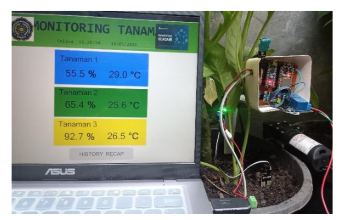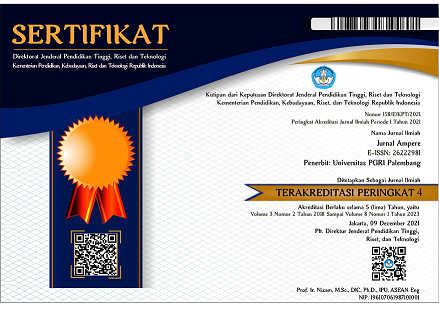Sistem Pemantauan dan Kendali Penyiraman Otomatis pada Tanaman menggunakan Logika Fuzzy berbasis Outseal SCADA
DOI:
https://doi.org/10.31851/ampere.v9i1.15183Keywords:
Penyiraman Tanaman, Sistem otomatis, Logika Fuzzy, SCADA HaiwellAbstract
Penyiraman tumbuhan sebagai aktivitas yang sangat vital, mengharuskan menyiram di waktu yang relatif. Sejalan dengan kemajuan teknologi, otomatisasi sistem sebagai sebuah solusi yang signifikan dalam mempermudah kehidupan manusia, terutama pada aspek penyiraman tumbuhan. Penelitian ini bertujuan membuatkan alat otomatisasi penyiraman tumbuhan menggunakan memakai penerapkan logika Fuzzy menggunakan metode Mamdani. Tujuan utamanya merupakan buat menentukan nilai kelembaban tanah serta suhu sekitarnya, yang nantinya diolah buat menghasilkan pola penyiraman yang sempurna buat tumbuhan, tepat pada kondisinya. Pada sistem ini, hasil pemantauan (output monitoring) akan ditampilkan di SCADA Haiwell, serta penyiraman otomatis nantinya akan dikendalikan memakai metode Logika Fuzzy
References
A. K. Nalendra and M. Mujiono, “Perancangan PERANCANGAN IoT (INTERNET OF THINGS) PADA SISTEM IRIGASI TANAMAN CABAI,” Gener. J., vol. 4, no. 2, pp. 61–68, 2020, doi: 10.29407/gj.v4i2.14187.
A. Pertiwi, V. E. Kristianti, I. Jatnita, and A. Daryanto, “Sistem Otomatisasi Drip Irigasi Dan Monitoring Pertumbuhan Tanaman Cabai Berbasis Internet of Things,” Sebatik, vol. 25, no. 2, pp. 739–747, 2021, doi: 10.46984/sebatik.v25i2.1623.
N. Hamida, “Monitoring Alat Penyiraman Tanaman Otomatis dengan Sensor Kelembaban Berbasis PLC Outseal dan Blynk,” 2022, [Online]. Available: https://repository.pnj.ac.id/id/eprint/7480/%0Ahttps://repository.pnj.ac.id/id/eprint/7480/1/HALAMAN IDENTITAS TUGAS AKHIR.pdf
L. Kabat, “PENERAPAN TEKNOLOGI AUTOMATIC DRIP IRRIGATION SYSTEM ( ADIS ) UNTUK MENINGKATKAN PRODUKTIVITAS CABAI DI Program Studi Agribisnis , Politeknik Negeri Banyuwangi , Jl . Raya Jember Km . 13 PENDAHULUAN Sentra utama cabai rawit merah terbesar ada di Kecamatan,” vol. 6, no. 1, pp. 1176–1184, 2020.
A. Rajagukguk, J. F. Simamora, and E. Ervianto, “Rancang Bangun Pengendali Sistem Pompa Otomatis Pada Penyiraman Tanaman Berbasis Sensor Kelembaban dengan Kendali Arduino,” PROtek J. Ilm. Tek. Elektro, vol. 8, no. 2, p. 76, 2021, doi: 10.33387/protk.v8i2.3122.
Titik Arsiyani, “Penyiraman Tanaman Otomatis Menggunakan Fuzzy Inference System (Fis) Metode Tsukamoto Berbasis Android,” J. TeknoSAINS, vol. 01, no. 01, pp. 1–14, 2018.
M. Alfiyanuddin, R. P. Astutik, and H. Ariwianto, “Implementasi Plc Outseal Sebagai Pengontrol Suhu Ruangan Peternakan Burung Walet Dengan Tampilan Hmi,” Elektron. Control. Telecomunication, Comput. Inf. Power Syst., vol. 8, no. 1, pp. 62–66, 2023.
W. C. Ningrat, “Implementation of PLC Outseal as a Controller of Ammonia Gas Circulation in Chicken Coops with HMI Modbus Monitoring,” Indones. Vocat. Res. J., vol. 2, no. 2, p. 1, 2023, doi: 10.30587/ivrj.v2i2.5480.
K. Almay Diantoro, W. Pudji Muljanto, and M. Ardita, “Desain Scada Untuk Monitoring Dan Kontrol Pembangkit Listrik Tenaga Sampah Mikro Kampus Ii Itn Malang”.
S. N. Putri and D. R. S. Saputro, “Construction fuzzy logic with curve shoulder in inference system mamdani,” J. Phys. Conf. Ser., vol. 1776, no. 1, 2021, doi: 10.1088/1742-6596/1776/1/012060.

Downloads
Published
How to Cite
Issue
Section
License
Copyright (c) 2024 Zamzamil Umam Zamzamil Umam, Denny Irawan

This work is licensed under a Creative Commons Attribution-ShareAlike 4.0 International License.

Jurnal Ampere is licensed under a Creative Commons Attribution-ShareAlike 4.0 International License.
Authors who publish with this journal agree to the following terms:
- Authors retain copyright and grant the journal right of first publication with the work simultaneously licensed under a Creative Commons Attribution License that allows others to share the work with an acknowledgement of the work's authorship and initial publication in this journal.
- Authors are able to enter into separate, additional contractual arrangements for the non-exclusive distribution of the journal's published version of the work (e.g., post it to an institutional repository or publish it in a book), with an acknowledgement of its initial publication in this journal.
- Authors are permitted and encouraged to post their work online (e.g., in institutional repositories or on their website) prior to and during the submission process, as it can lead to productive exchanges, as well as earlier and greater citation of published work.





